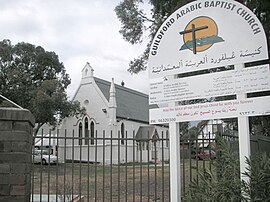Old Guildford, New South Wales
|
Old Guildford Sydney, New South Wales |
|||||||||||||||
|---|---|---|---|---|---|---|---|---|---|---|---|---|---|---|---|

Guidlford Arabic Baptist Church
|
|||||||||||||||
| Coordinates | 33°51′57″S 150°59′0″E / 33.86583°S 150.98333°ECoordinates: 33°51′57″S 150°59′0″E / 33.86583°S 150.98333°E | ||||||||||||||
| Population | 2,663 (2016 census) | ||||||||||||||
| Established | 1837 | ||||||||||||||
| Postcode(s) | 2161 | ||||||||||||||
| Location | 24 km (15 mi) west of Sydney CBD | ||||||||||||||
| LGA(s) | City of Fairfield | ||||||||||||||
| State electorate(s) | Fairfield | ||||||||||||||
| Federal Division(s) | McMahon | ||||||||||||||
|
|||||||||||||||
Old Guildford is a suburb of Sydney, in the state of New South Wales, Australia 24 kilometres west of the Sydney central business district, in the local government area of the City of Fairfield. It is part of the Greater Western Sydney region.
Old Guildford and Guildford were named after the Earl of Guildford.
Prior to colonisation, the Dharug people lived in small groups across the Cumberland Plain, including in the area which is now the Woodville Ward. The Bidjigal clan lived around the area which is now Guildford.
Lieutenant Samuel North was granted 640 acres (2.6 km2) here on 1837 and named his property Guildford, as he had ties with the Earl of Guildford. Although the name of the property changed to Orchardleigh in 1843 when it was sold by North, the name Guildford stuck to the region and the small hamlet which developed in the area around Woodville Road. In 1869 a school had opened and a church was built in the 1880s.
In 1876, a railway station was built on the line some distance to the north of the village and named Guildford because it was the closest settlement to the station. The settlement that grew up around the railway station became larger than the original village and ultimately took over the name Guildford with the former settlement becoming known as Old Guildford.
According to the 2016 census, Old Guildford had a population of 2,663 people with a very substantial Arabic speaking population (46.2%). The majority of the suburb's residents were Australian born with the next most common place of birth being Lebanon (13.1%) followed by Vietnam (2.4%), China (2.1%), Iraq (1.9%) and Syria (1.7%). Top ancestries were Lebanese (35.1%), Australian (11.8%), English (6.8%), Chinese (4.9%) and Syrian (2.9%).
...
Wikipedia

